Sourdough Pasta Dough
Silky, tender, and full of flavor, this sourdough pasta turns discard into something special. The dough comes together easily, rolls out smooth, and cooks in minutes for fresh pasta that holds its shape and soaks up sauce beautifully.
Servings: 6 servings
Ingredients
- 2 cups all-purpose flour or 00 flour, 240 grams
- 1 teaspoon salt
- 1 cup sourdough starter fed or unfed, 240 grams
- 2 large egg yolks
- 4 teaspoons olive oil
- 3 to 10 teaspoons water
Instructions
- On a clean work surface or in a bowl, mound the flour and sprinkle in the salt. Make a well in the center and add the sourdough discard, egg yolks, olive oil, and 3 to 4 teaspoons of water.
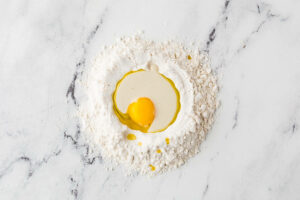
- Use a fork to gradually pull flour into the center. The mixture will look dry and crumbly at first, that’s normal.If you started mixing in a bowl, dump everything onto the counter. Use a bench scraper in a chopping and scraping motion to pull the dry bits back into the dough. Chop, scrape, and gather repeatedly. You’re not kneading yet, just coaxing the flour and liquid together.
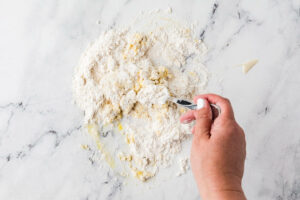
- Once the dough starts clumping into rough pieces, press them together with your hands to form a shaggy mass. If it refuses to hold together, add water 1 teaspoon at a time, chopping and mixing it in with the bench scraper until the dough holds together when squeezed.
- Knead by hand (or in a stand mixer with a dough hook) for 8–10 minutes. Pasta dough is denser than bread dough, so it will feel stiff and dry at first. Keep going, it will gradually become smoother, more elastic, and easier to work with.
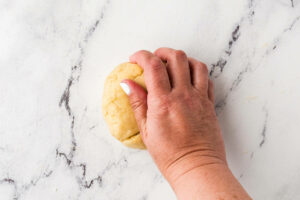
- If the dough is sticky, dust it lightly with flour. If it feels too dry and cracks as you knead, wet your hands and keep going until the moisture works in.
- Wrap tightly in plastic wrap and let rest at room temperature for at least 30 minutes to relax the gluten.
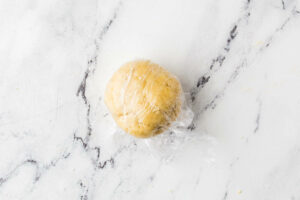
- Divide the dough into 2–3 pieces. Keep the pieces you’re not working with covered in plastic wrap so they don’t dry out.
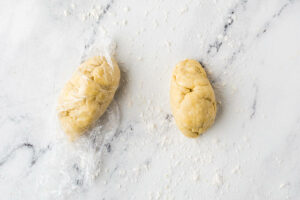
- Roll one piece into a thin sheet with a rolling pin or pasta machine, dusting with flour as needed to prevent sticking. If the dough keeps bouncing back or resists rolling, let it rest for 1–2 minutes to relax the gluten, then try again.
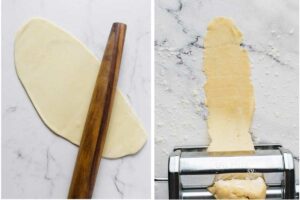
- Cut into your desired shape: tagliatelle (thin ribbons), pappardelle (wide ribbons), or rustic hand-cut strips.
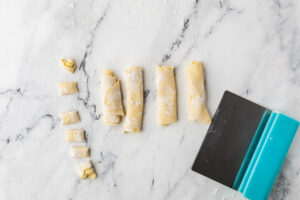
- Dust the cut noodles lightly with flour, then coil them into loose nests and set them on a floured tray while you roll and cut the remaining dough. For sturdier noodles, dust the cut pasta with flour or semolina and let it rest for 15–20 minutes before boiling.
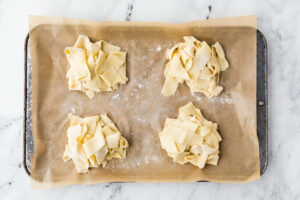
- Bring a large pot of salted water to a rolling boil. Add the pasta in small batches so the strands have room to move freely. Stir gently but continuously during the first 30–60 seconds to prevent sticking. Cook for 2–3 minutes, or until al dente. Fresh pasta cooks quickly, so keep an eye on it. Drain and toss immediately with your favorite sauce.
Notes
Kneading: Don’t shortchange this step. Under-kneaded dough tears easily and won’t roll thin. Properly kneaded dough should feel firm but pliable, and when you press a finger into it, the surface should slowly spring back.
Hydration: Egg yolk sizes can vary, so start with a small amount of water and add more water if the dough is too dry. If the dough feels too sticky, dust lightly with flour until it’s manageable.
Sourdough discard can vary in thickness. Older discard tends to be more liquidy, which can make the dough stickier. If using older discard, you may need to add more flour until the dough is firm but pliable.
Bench scraper: This tool makes the early mixing stage easier. Use it to chop, scrape, and gather the shaggy dough before it comes together, which helps prevent adding too much water too quickly. It also keeps your work surface tidy and helps you fold flour into the dough evenly..
Food processor option: You can also pulse the ingredients together in a food processor until a crumbly dough forms, then finish kneading by hand for 1–2 minutes to smooth it out. It’s quicker, but you’ll still want to knead it to develop the gluten properly.
Cooking Fresh Pasta: Cook the pasta in small batches, stirring gently for the first 30–60 seconds to prevent sticking. Fresh pasta cooks quickly, usually 2–4 minutes, depending on thickness, so taste early and drain when al dente. For sturdier noodles, dust with flour/semolina and rest 15–20 minutes before boiling.
Egg-free option: Skip the egg yolks and increase the discard by 3 to 4 tablespoons.
Long ferment option: You can refrigerate the wrapped dough for up to 24 hours before rolling it out. This gives the flour more time to hydrate and develops a slightly deeper flavor. Be aware that if stored longer than 24 hours, the dough may start to oxidize and darken in color.
All-purpose vs. 00 flour: All-purpose flour gives the pasta a slightly firmer, more rustic texture. 00 flour is milled finer, making a silkier, softer dough that’s easier to roll very thin. Both work well, use what you have or what suits your pasta style.
Storage: You can dry the pasta on a rack and store in an airtight container for up to a week, or freeze fresh noodles in a single layer, then transfer to a bag.
Nutrition
Serving: 1 serving | Calories: 232kcal | Carbohydrates: 40g | Protein: 6g | Fat: 5g | Saturated Fat: 1g | Polyunsaturated Fat: 1g | Monounsaturated Fat: 3g | Cholesterol: 65mg | Sodium: 392mg | Potassium: 51mg | Fiber: 1g | Sugar: 0.1g | Vitamin A: 87IU | Calcium: 14mg | Iron: 2mg
